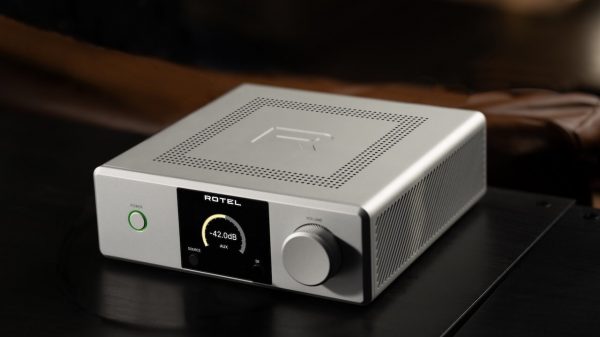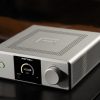Integrated amplifiers like the Cyrus Audio i7-XR have me excited for the future of high-end audio; it delivers excellent sound quality, build quality, and a remarkably good phono pre-amplifier that makes listening to vinyl an absolute joy.
It is no secret that I love and use integrated amplifiers from Croft Acoustics, Cambridge Audio, Audiolab, Schiit Audio, and NAD at home; I have given up on complex systems with a rack of separates and I don’t feel like I’m missing out at all when it comes to connectivity, power, or sound quality.
The one thing that the Cyrus Audio i7-XR and the aforementioned amplifiers are missing is an internal streamer and for some people that might be a deal breaker if they are looking for a one-box solution. The Naim Uniti Atom delivers everything but an internal phono pre-amplifier so there isn’t one perfect solution for everyone.
I ran my Bluesound NODE into the i7-XR and it worked flawlessly.
Did you know that Cyrus Audio have had a network streaming player in the market for almost 7 years? It’s become slightly long in the tooth but changes are coming and the company is investing heavily in streaming technology and network amplifiers.
It was all the rage in the U.K., but nobody on these shores deemed it worthwhile to cover.
One of the interesting things I learned during my discussions with Cyrus recently was that the decision to integrate Bluesound’s BluOS in their digital streaming products was only part of the long-term plan.
If you surmised that Cyrus Audio saw the writing on the wall and realized that it was more economical and expedient to integrate an already proven streaming platform into their products — you would be correct.
I suspect we’re going to see some interesting collaboration between Lenbrook and Cyrus going forward and that’s a positive development.
Cyrus Audio were very kind and sent me the $3,799 USD Cyrus Audio i7-XR Integrated Amplifier and $2,995 USD CDi-XR CD Player.

The CDI-XR (review forthcoming) is $2,000 more than the Marantz CD60 that I just reviewed and proved to be a bit of a chameleon as you will find out next week; it is definitely one of the best sounding CD players I’ve tried in many years and the tank-like build quality left me convinced that it will prove to be very reliable for the long haul. I ran more than 100 CDs through it during the review process and only one badly scratched DCC recording skipped.
The Skinny
The elongated die-cast box is built like a tank and minus some weird binding posts, this amplifier is likely to last a very long time. It’s handmade in England and the form and function are excellent.
I know that the industrial design has alienated people over the years but I rather like the simplicity of it and it does feel very inert in your hands; you will never break your back installing this amplifier which only weighs 11 pounds.
The chassis is 73 x 215 x 360 mm (H x W x D) and never became more than lukewarm even when I drive the amplifier extremely hard with more difficult loudspeakers. The heatsinks and ventilation do a very effective job keeping this amplifier cool even on very warm summer days.
The Cyrus i7-XR is a 52 watts/channel integrated amplifier but that number is quite deceptive; it can drive a wide range of loudspeakers quite easily.
The pre-amplifier section of the i7-XR is derived from the circuit of the Cyrus Audio Pre-XR preamplifier; the i7-XR analog preamp features relay input selection and a new high-performance gain stage. This short-path design makes the analog pre-amplifier extremely transparent sounding.
The i7-XR is designed for hi-res digital playback and is one of its strongest features.
The DAC input stage of the i7-XR features a new 2nd generation version of Cyrus’ QXR DAC, but with an all-new high-speed analogue buffer stage. Seven digital filter alignment options are user adjustable to suit the taste of the listener. Input options include USB audio (to 384k sample rate) and DSD to DSD256.
The i7-XR is also Roon Tested which means that Cyrus Audio and Roon have collaborated to ensure you have the best experience using Roon software and Cyrus equipment together; I confirmed this by running my MacBook Pro into the USB input and using the desktop version of Roon.
The connectivity options are quite plentiful and while the rear panel can get rather congested if you connect more than 3 sources, a thick pair of speaker cables, and power cord — it is very easy to read and use.
The placement of the headphone output on the rear panel makes no sense because unless the i7-XR is being installed on an open credenza or media unit that you can reach behind with zero difficulty, it’s a major pain in the buttocks to use.
What makes that even more unfortunate is that the internal headphone amplifier is very good and a good match for a lot of headphones. Cyrus should seriously reconsider its placement on future versions of their amplifiers.
The i7-XR features:
- 4 x Analogue inputs
- 1 x Phono MM input
- 2 x Optical inputs
- 2 x Coaxial digital inputs
- 1 x Asynchronous USB input
- 1 x Analogue preamplifier out
- 1 x Headphone output

Having done some research on older Cyrus Audio designs, it’s clear to me that they have redesigned what was a somewhat clunky interface and I’m very keen on what they have done.
The front panel buttons are flush with the casework and proved to be very responsive to the touch; the unit responds almost immediately to any changes of source or volume. It looks very sleek and modern and I applaud Cyrus for making the necessary changes.
Visibility is fine from about 10 to 15 feet away and even my old and tired eyes had zero difficulty reading the on-screen information.
The supplied remote controls are plastic, but offer total control of the unit and all of its functions. The buttons are backlit and I found myself using the remote in the dark quite frequently without any issues.
My biggest gripe is the binding posts; had Cyrus not provided me with adapters to attach to my QED loudspeaker cables — I would have been out of luck. My QED XT-40i cables are already terminated with hollow banana pins but I needed the adapters so that they would fit over the internal binding posts.
Not a fan.
System
The Cyrus Audio i7-XR gets sold with a lot of PMC, ATC, ProAc, and Spendor loudspeakers; I owned a pair of Spendor SP2/3 for almost a decade but a clumsy mover destroyed them in New York City and I’ve been unable to afford a replacement pair since.
I can understand the Cyrus/Spendor combination because the tonal balance of the Spendor Classic Series is almost perfect for the i7-XR.
I was not about to drive my Magnepan LRS with the i7-XR but I did have 4 pairs of loudspeakers from Q Acoustics and Wharfedale at home when the review system arrived and they all proved to be an excellent match.
The Wharfedale Linton were a short-term loan from a friend because Wharfedale doesn’t get enough love from us apparently (only 10 articles in 18 months) and will not return my emails. I own the Diamond 10.1s, Q Acoustics 3050i and 3030i loudspeakers and use them all on a daily basis.
Sources included the Cyrus Audio CDI-XR CD Player, Bluesound NODE, Pro-Ject Debut PRO, Yamaha YP-701, and Thorens TD-145 MKII Turntables.
Sound
If you’re going to spend a few thousand dollars on an integrated amplifier, it better deliver a heart-stopping performance and make rival products from Naim, Cambridge Audio, and Rega start sweating.
Does it succeed in that regard?
As I mentioned, the industrial design is definitely polarizing for some; the Rega Aethos and Naim SuperNait 3 are more attractive looking products but I’m not sure that they best the Cyrus Audio i7-XR when it comes to pacing, transparency, or detail.
Both the Rega and Naim are smoother sounding amplifiers; the Aethos is much warmer sounding than the Cyrus in the midrange but it’s definitely not as agile.
Same deal with the Naim which is rather amazing. Naim built its reputation on pace, rhythm, and attack — but does it sound less nimble and bouncy than the Cyrus?
That aspect is slightly closer, but the Cyrus is exceptional in that regard.
It definitely doesn’t sound like a tube amplifier. Not even remotely. It’s not razor flat because the bottom end has a fair bit of heft, texture, and impact, whereas the midrange is perfectly neutral sounding and the treble is superbly clean and detailed.
It’s not a sweet sounding treble; bad recordings with a hot top end get exposed really quickly. All of that means that system matching is beyond important with both Cyrus products.
It’s no secret that I enjoy my coffee black with some raw sugar and a tiny amount of cream.
Listening to Billie Holiday, Sarah Vaughan, and Johnny Hartman, I was reminded why I love the British sound so much; warm, dynamic, punchy, and that feeling that I could almost reach out and gently stroke Sarah Vaughan’s cheek as she sang.
The i7-XR is not a warm sounding amplifier at all and I would caution its use with loudspeakers that are too neutral or analytical; what you gain in detail and transparency — you lose in texture, color, and presence.
The Linton have excellent bass response but I find it somewhat hazy and soft with the wrong amplifier; the i7-XR grips it with both hands and solidifies every note in a very effective way.
When I switched over to Bruce Springsteen’s The Ghost of Tom Joad, I was reminded just how forceful of an amplifier the Cyrus i7-XR can be with the right pair of loudspeakers; the imaging was quite good but I was more impressed with the overall presence in the room.
Springsteen is never being confused with Sam Cooke, but he’s in better form on this underrated album and the 4 loudspeakers all recreated him in their respective rooms with a level of clarity and detail that certainly kept my attention throughout.
The phono stage is excellent and really meshed well with the Goldring, Grado, and Sumiko MM cartridges that I ran through it; it is bolder sounding than the internal DAC and I found myself listening to more records than CDs or streaming platforms like TIDAL and Qobuz.
Conclusion
The integrated amplifier category is very competitive and a product has to really stand out to push its way to the front of the line. The Cyrus Audio i7-XR does that but not without a few quirks; weird binding posts and a headphone jack that needs to be on the front.
I waited well over a decade to finally audition a Cyrus Audio system and I must say that I sent it back feeling quite satisfied; it does things differently than comparable products from Rega, Naim, and Cambridge Audio and definitely marches to its own drummer.
The i7-XR doesn’t deliver the finesse, color, slam, or unlimited power of my Cambridge Audio Edge A, but it does almost everything else just as well for almost $3,000 less and that makes it quite the bargain with the right pair of loudspeakers. Cyrus Audio enters its 40th year in great shape with products that are very well engineered and very solid performers for the money. Highly recommended.
Where to buy: $3,799 at World Wide Stereo


































